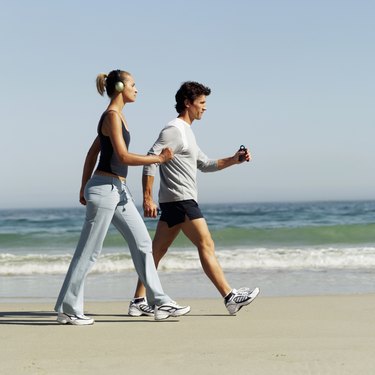
Walking is one of the easiest cardio exercises you can do, and it's an exercise that comes loaded with health and fitness benefits. As well as helping you maintain a healthy cardiovascular and respiratory system, walking keeps many important muscle groups working, key muscles that you use every day. The American College of Sports Medicine recommends at least 150 minutes of moderate-intensity exercise every week. Engaging your muscles with a regular walk every day will contribute to your weekly exercise target, and it will also reduce your chances of suffering pulls and strains.
Pushing Off
Video of the Day
As you walk forward, you move your thighs and hips backward. This movement engages the gluteus muscles in your butt and a number of key muscles in your hamstrings, which are located at the back of your thighs. These muscles include your semitendinosus, semimembranosus, and biceps femoris. This walking forward motion also engages one other small muscle located at the top of your inner thigh, which is your adductor magnus.
Video of the Day
Walking Ahead
The second motion involved in walking is the action of moving your legs forward. This action engages all the major muscles in your thigh, including your quadriceps. These muscles are located in the front of your thighs, and this is also where another major muscle is engaged, your sartorius. This is the longest muscle in your body, and it stretches down from the top of your thigh, curving inside your thigh, ending at the inside part of your knee. The point where your hips and thighs meet will also get a workout, and the muscles engaged here include your iliopsoas, tensor fasciae latae, pectineus, and adductor longus and brevis.
Finding Your Stride
As your feet hit the floor, normally with a heel-to-toe movement, your calves interact with your ankles to allow each foot to be pulled back on forth. This part of your walk will engage your gastrocnemius, soleus, plantaris, and tibialis posterior and anterior muscles. Your flexor hallucis posterior and flexor digitorum longus muscles, thin muscles that help you to curl your toes, are activated here too. Also engaged when moving your feet and ankles are your extensor digitorum longus and hallucis longus muscles, which extend down from your knee on the front of your shin.
Strong Back and Sides
Walking will cause you to move from side to side as you shift your weight from one leg to the other, and this action engages your hips, abs, waist and the muscles that support your back and general spine area. The specific muscles used are the oblique muscles in your sides, which handle how you twist and flex your trunk. Also used are the quadratus lumborum and multifidus muscles, which do the same job, supporting your lower back. Your abs will also be engaged, as will the large group of muscles sitting on either side of your spine called the erector spinae.